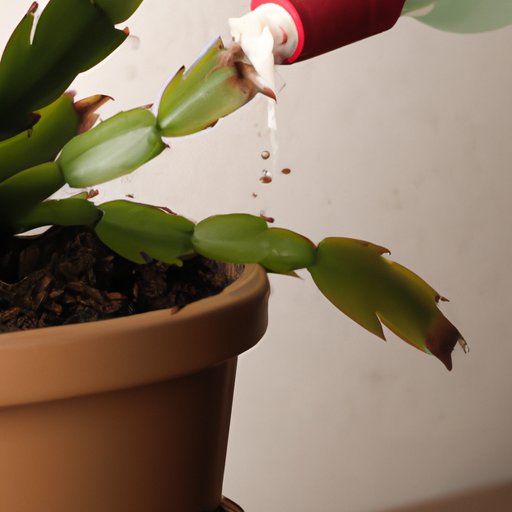I. Introduction
Christmas cactus, scientifically known as Schlumbergera, is a tropical plant native to Brazil. It is a favorite among indoor plant enthusiasts because of its blooming cycle that coincides with the holiday season. The plant can live for many years with the right care and attention, and can be passed down from generation to generation as a family heirloom. In this article, we will explore the unique characteristics, growth habits, and care requirements of the Christmas cactus.
II. Watering and Soil
The proper watering and soil conditions are vital for the health of the Christmas cactus. Overwatering or underwatering can cause the plant to wilt, drop its leaves, and even die.
Christmas cactus needs a well-draining soil mix that is rich in organic matter. You can achieve this by mixing equal parts of peat moss, perlite, and potting soil. The soil should be moist but not soggy, and should dry out slightly between watering.
During the growing season (spring and summer), Christmas cactus requires frequent watering to promote growth and flowering. Water the plant thoroughly until water runs out of the drainage holes, then let it drain completely before placing it back in its saucer. In the winter months, water sparingly and only when the top inch of soil feels dry.
III. Temperature and Humidity Control
Christmas cactus thrives in warm, humid conditions with bright, indirect light. Ideally, it should be placed in a room with a temperature range of 60-70F (16-21C) and humidity levels of 50-60%. Dry air can cause the plant to lose its buds and flowers, so it is essential to provide enough warmth and moisture in the air.
You can increase the humidity levels by placing a humidity tray filled with pebbles and water beneath the plant or by misting the leaves regularly with a spray bottle. Avoid placing the plant in drafty areas or near heat sources like radiators and air vents.
IV. Pruning and Propagation
Christmas cactus can grow up to 3 feet wide and tall if left unpruned. Overcrowding can cause the plant to become leggy, which results in fewer blooms. It is essential to prune the plant regularly to maintain its shape and promote blooming.
To prune a Christmas cactus, use sharp, sterile scissors to carefully cut off any dead or diseased stems. You can also prune the plant to a more compact shape by cutting back any leggy stems just above a leaf node.
Propagation of the Christmas cactus is easy and can be done by stem or leaf cuttings. Choose a healthy stem or leaf and let the cuttings dry out for a day or two before planting them in a well-draining soil mix. Keep the soil moist but not saturated and place the cuttings in bright indirect light until they have established roots.
V. Fertilizing Needs
The Christmas cactus requires regular feeding during the growing season to promote healthy growth and blooming. Use a balanced, water-soluble fertilizer that is rich in nitrogen, phosphorus, and potassium every two weeks from spring to fall. Avoid over-fertilization as it can lead to the buildup of salts in the soil, which can harm the roots.
VI. Potting and Repotting
Christmas cactus prefers to be slightly root-bound, and repotting should be done only when necessary. Signs that your plant needs repotting include root-bound plant, wilting, or yellow leaves, and stunted growth. During the growing season, you can repot the plant every two to three years using fresh soil mix and a new pot that is only slightly bigger than the old one.
When repotting, remove the plant from its old pot gently, untangle the roots, and trim off any rotten or dead roots. Then, plant the Christmas cactus in fresh potting soil mix, water it thoroughly, and let it drain completely.
VII. Pest Prevention and Solutions
Christmas cactus is relatively free from pests, but it is still susceptible to certain insects such as mealybugs, scale, and spider mites. Early signs of infestation include yellowing or drooping leaves, white webbing, and tiny dots on the plant. The best way to control pests is to catch them early and treat them immediately.
You can use insecticidal soap or horticultural oil to control the pests. Apply the solution every two weeks until the pests are gone. You can also use a solution of water and mild dish soap to wash off any visible insects on the plant.
VIII. Conclusion
The Christmas cactus is a beautiful, low-maintenance plant that can add color and beauty to any home during the holiday season. With proper care and attention, it can thrive and last for many years. Remember to provide the right watering, soil, temperature, and humidity conditions, prune the plant regularly, fertilize it correctly, and repot it only when necessary. By following these care tips, you can enjoy a healthy and vibrant Christmas cactus.
For additional guidance on caring for your Christmas cactus, you can consult with your local nursery or seek advice from online plant communities.
